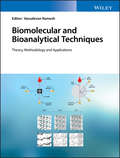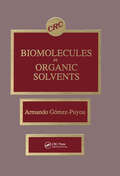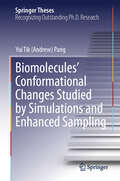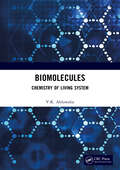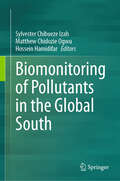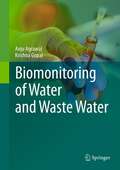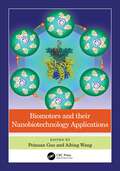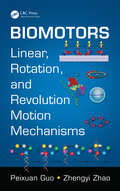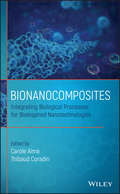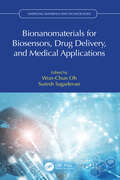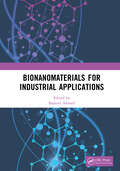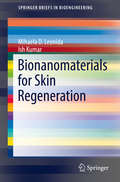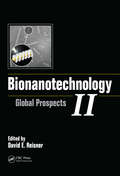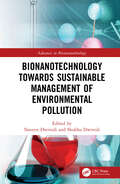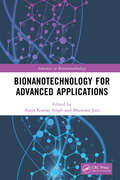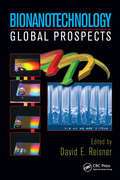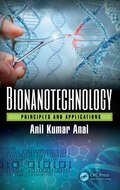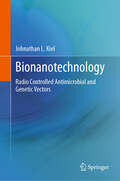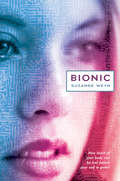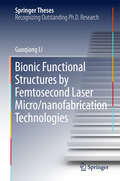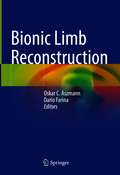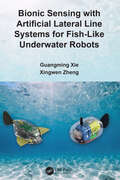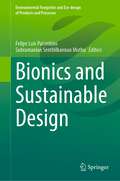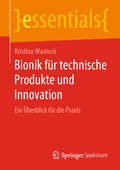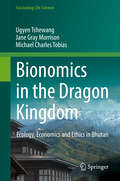- Table View
- List View
Biomolecular and Bioanalytical Techniques: Theory, Methodology and Applications
by Vasudevan RameshAn essential guide to biomolecular and bioanalytical techniques and their applications Biomolecular and Bioanalytical Techniques offers an introduction to, and a basic understanding of, a wide range of biophysical techniques. The text takes an interdisciplinary approach with contributions from a panel of distinguished experts. With a focus on research, the text comprehensively covers a broad selection of topics drawn from contemporary research in the fields of chemistry and biology. Each of the internationally reputed authors has contributed a single chapter on a specific technique. The chapters cover the specific technique’s background, theory, principles, technique, methodology, protocol and applications. The text explores the use of a variety of analytical tools to characterise biological samples. The contributors explain how to identify and quantify biochemically important molecules, including small molecules as well as biological macromolecules such as enzymes, antibodies, proteins, peptides and nucleic acids. This book is filled with essential knowledge and explores the skills needed to carry out the research and development roles in academic and industrial laboratories. A technique-focused book that bridges the gap between an introductory text and a book on advanced research methods Provides the necessary background and skills needed to advance the research methods Features a structured approach within each chapter Demonstrates an interdisciplinary approach that serves to develop independent thinking Written for students in chemistry, biological, medical, pharmaceutical, forensic and biophysical sciences, Biomolecular and Bioanalytical Techniques is an in-depth review of the most current biomolecular and bioanalytical techniques in the field.
Biomolecules in Organic Solvents
by Armando Gomez-PuyouBiomolecules and Organic Solvents discusses the behavior of enzymes and multi-enzyme complexes in organic solvents, in addition to the problem of water-protein interactions and the characteristics of water at interphases. It attempts to bridge the gap between the all water and the organic solvents systems from the point of view of enzyme structure and function. The mechanism of action of enzymes dispersed in anhydrous organic solvents and the biotechnological perspectives of the field are evaluated, and new information regarding the function and characteristics of complex multi-enzymatic systems and whole cells in organic solvents are examined. New developments regarding the nature of the water pool and interphases of reverse micelles and their enzyme kinetics are also explored. The characteristics and properties of enzymes trapped in reverse micelles are discussed throughout the book. Biomolecules in Organic Solvents is essential reading for biochemists, molecular biologists, and others working in related fields.
Biomolecules' Conformational Changes Studied by Simulations and Enhanced Sampling (Springer Theses)
by Yui Tik PangThis thesis illuminates the critical roles biomolecules, from small molecules to proteins, play in cellular functionality, particularly highlighting their conformational changes in response to environmental cues or binding events—a cornerstone concept in drug design as well as the manifestations of disease. It explores the conformational flexibility of small molecules and proteins, essential for predicting drug interactions and understanding biological processes. Through advanced molecular dynamics simulations and enhanced sampling techniques, this research offers unprecedented insights into the structural dynamics of three distinct biomolecular systems: the capsid assembly modulator AT130, the passenger domain of pertactin, and the SARS-CoV-2 spike protein. Each system represents a unique facet of biological complexity, underscoring the thesis's contribution to our understanding of biomolecular behavior across various scales. Furthermore, the thesis advances the field by updating the Force Field Toolkit for improved simulation accuracy. This work not only showcases the adaptability and importance of simulation techniques in modern biological research but also paves the way for novel therapeutic strategies by deepening our understanding of biomolecular dynamics.
Biomolecules: Chemistry of Living System
by V.K. AhluwaliaBiomolecules, also known as molecules of life, are essential for sustaining life processes. This book presents a study of these crucial biological substances to explore their function, structure, biological role, and synthesis. It also expands upon the various types of biomolecules and discusses their individual characteristics.The subject matter of this book also covers: Mucopolysaccharides Tertiary Structure of Proteins Caffeine Mechanism of Enzyme Action Biosythesis of Haemoglobin Print edition not for sale in South Asia (India, Sri Lanka, Nepal, Bangladesh, Pakistan or Bhutan)
Biomonitoring of Pollutants in the Global South
by Sylvester Chibueze Izah Matthew Chidozie Ogwu Hossein HamidifarThe edited book serves as a reference on indicators of environmental pollution and how to sustainably ascertain the effects of different pollutants on life forms. It addresses an improved technology for monitoring contaminants, especially in the Global South and beyond, where the level of technology available for sustainable management of environmental quality is limited. Biomonitoring ecosystems' health by using organisms to gather quantitative data on environmental quality is one of the most straightforward and affordable ways to check environmental quality. Since organisms may function as environmental sensors, their use in the direct measurement of environmental quality in the process of biomonitoring studies implicates the health status of various ecosystems. In this regard, microorganisms, higher and lower plants, invertebrates, and vertebrate animals are beneficial since they can detect pollution levels and pollutants in the environment. This book is of interest and useful to toxicologists, water, soil, and air quality experts, practitioners, trainees, and trainers, biological sciences scientists, academicians, researchers, students (especially undergraduates and postgraduates), libraries, and other public knowledge repositories interested in novel and advanced practices in sustainable biomonitoring of environmental pollutants.
Biomonitoring of Water and Waste Water
by Krishna Gopal Anju AgrawalBiomonitoring of water quality is very much essential for assessing the overall health of water bodies and safe supply of drinking water. The chemical nature of toxicant is highly dynamic in environment with time and space whereas biological system can integrate all environmental variables over a large period of time in terms of effect that can be easily measured and quantified. In view of the above, there is a pressing need to determine the water quality of natural resources as well as drinking water based on the standard protocols and guidelines from regulatory agencies. It is clear that the synthetic chemicals are essential for our society to maintain the health and well being of the people. However, there has been a range of detrimental effects on human health and natural environment. In general, we need to improve our management of waste chemicals discharged into the air, water and soil environments. New techniques are needed to predict adverse effects before they occur and for the treatment of wastes. In addition, a range of social, political and economic factors will be needed to be taken into account in order to achieve success.
Biomotors and their Nanobiotechnology Applications
by Peixuan GuoThis book – a collection of reviews and research articles by the top academics in the field – provides a glimpse of the cutting-edge technology and research being carried out and shows how researchers are utilizing this knowledge to develop new areas of study and novel applications. It serves as a valuable resource while exploring the latest advances in virus particle assembly and demonstrating how the knowledge of fundamental processes has been used to advance bio-nanotechnology. Chapters detail biophysical approaches and biomotor research, discus the latest advances in DNA/RNA nanoparticle assembly and use, and introduce the use of DNA/RNA nanoparticles for drug delivery.
Biomotors: Linear, Rotation, and Revolution Motion Mechanisms
by Peixuan Guo and Zhengyi ZhaoThis book provides a comprehensive overview of biomotors (molecular motors) within the body with a specific concentration on revolving molecular motors. The bioengineering of these new revolving molecular motors will go a long way in creating machines that will be able to carry RNA and DNA drugs directly to diseased cells to destroy them. The book goes into specific details regarding the bioengineering, fabrication, synthesis, and future utilization of these devices for nanomedicine.
Bionanocomposites: Integrating Biological Processes for Bioinspired Nanotechnologies
by Thibaud Coradin Carole AiméBeginning with a general overview of nanocomposites, Bionanocomposites: Integrating Biological Processes for Bio-inspired Nanotechnologies details the systems available in nature (nucleic acids, proteins, carbohydrates, lipids) that can be integrated within suitable inorganic matrices for specific applications. Describing the relationship between architecture, hierarchy and function, this book aims at pointing out how bio-systems can be key components of nanocomposites. The text then reviews the design principles, structures, functions and applications of bionanocomposites. It also includes a section presenting related technical methods to help readers identify and understand the most widely used analytical tools such as mass spectrometry, calorimetry, and impedance spectroscopy, among others.
Bionanomaterials for Biosensors, Drug Delivery, and Medical Applications (Emerging Materials and Technologies)
by Suresh Sagadevan Won-Chun OhThis book covers advances in nanostructured materials across a variety of biomedical applications as the field evolves from development of prototype devices to real-world implementation. It provides an in-depth look at the current state of the art in oxide nanostructures, carbon nanostructures, and 2D material fabrication and highlights the most important biomedical applications and devices of nanomaterials, including drug delivery, medical imaging, gene therapy, biosensors, and diagnostics. FEATURES Presents the findings of cutting-edge research activities in the field of nanomaterials, with a particular emphasis on biological and pharmaceutical applications Details finished and ongoing toxicity evaluations of emerging nanomaterials Offers a multidisciplinary perspective This book is recommended for senior undergraduate and graduate students, professionals, and researchers working in the fields of bioengineering, materials science and engineering, and biotechnology.
Bionanomaterials for Industrial Applications
by Shakeel AhmedBionanomaterials for Industrial Applications is a comprehensive guide to the current state of bionanomaterials research and their prospective applications in a variety of industrial sectors. The book discusses the properties of bionanomaterials, types and their potential applications in various disciplines, such as biomedicine, food industry, environment, etc. It provides a comprehensive overview of the current state of bionanomaterials research and their potential applications, making it an indispensable resource for anyone interested in learning more about this dynamic and rapidly developing field.Features: Discusses properties, classifications, and synthesis of bionanomaterials in addition to industrial applications Covers circular economy and life cycle assessment of bionanomaterials Explores impact of bionanomaterials on environment and human health Includes individual chapters specifically focusing on a particular application of bionanomaterials Reviews detailed industrial applications in particular field viz. environmental, food sciences, biomedical, and so forth This book is designed for researchers, scientists, engineers, and graduate students working in the field of bionanomaterials, as well as industrial professionals who could benefit from the use of bionanomaterials.
Bionanomaterials for Skin Regeneration (SpringerBriefs in Bioengineering)
by Mihaela D. D. Leonida Ish KumarThis book gives a concise overview of bionanomaterials with applications for skin regeneration. The advantages and challenges of nanoscale materials are covered in detail, giving a basic view of the skin structure and conditions that require transdermal or topical applications. Medical applications, such as wound healing, care for burns, skin disease, and cosmetic care, such as aging of the skin and photodamage, and how they benefit from bionanomaterials, are described in detail. A final chapter is devoted to the ethical and social issues related to the use of bionanomaterials for skin regeneration. This is an ideal book for researchers in materials science, medical scientists specialized in dermatology, and cosmetic chemists working in formulations. It can also serve as a reference for nanotechnologists, dermatologists, microbiologists, engineers, and polymer chemists, as well as students studying in these fields.
Bionanotechnology II: Global Prospects
by David E. ReisnerThe impact and importance of nanotechnology continues to grow, and nanomedicine and biotechnology have become areas of increased development. Biomedical engineers who work with biological processes and structures must have a deeply rooted understanding of the role of bionanotechnology, a rapidly evolving sector of the nanotechnology field. Bionanot
Bionanotechnology Towards Sustainable Management of Environmental Pollution (Advances in Bionanotechnology)
by Naveen Dwivedi Shubha DwivediThis book highlights the characteristics, aims, and applications of bionanotechnology as a possible solution for sustainable management and bioremediation of environmental pollutants. It covers remediation of toxic pollutants, removal of emerging contaminants from industrial wastewater, eco-design and modification study of bio-nanoparticles and life-cycle assessment, nano-filtration, bio-nanomaterials based sensors for monitoring air and water pollution, resource recovery from wastewater, and highlights Internet of things-based green nanotechnology.Provides a comprehensive solution of environmental problems in sustainable and cost-effective modeReviews bionanotechnological applications in nanomaterials design, modification, and treatment of emerging contaminants from industrial wastewater.Covers Eco-design study of bio-nanomaterials, bio-nano filters, and assessment for the treatment of emerging pollutantsIncludes IoT- based bionanotechnologyExplores future research needs on bionanotechnology and scientific challenges in the mitigation of environmental pollutantsThis book is aimed at researchers, professionals, and graduate students in nanobiotechnology, environmental engineering, biotechnology.
Bionanotechnology for Advanced Applications (Advances in Bionanotechnology)
by Ajaya Kumar Singh Bhawana JainThis book provides the fundamental aspects of bionanomaterials and bionanotechnology, and insight into the synthesis and modification of bionanomaterials in a detailed manner. It initiates with a general overview of biotechnology and nanotechnology followed by different strategies and methodologies for the synthesis of nanomaterials. Further, it discusses pertinent topics such as protein engineering, analysis, mechanisms of microbe- mediated nanosynthesis, followed by various challenges and innovation strategies, and the role of enzymes in bionanotechnology.Features: Covers the synthesis of bionanomaterials, including the interaction between nanomaterial and biogenic materials Encompasses the study of the connections between structure, molecular biology, and nanotechnology Explains several techniques (XRD, SEM, TEM, etc.) used for the analysis of bionanomaterials Includes prospects, challenges, and opportunities associated with bionanotechnology Reviews the interaction between nanomaterials and the biological system and self- assembly in bionanotechnology This book is aimed at graduate students and researchers in materials sciences, biotechnology, and bionanotechnology.
Bionanotechnology: Global Prospects
by David E. ReisnerAs the impact and importance of nanotechnology continues to grow, nanomedicine and biotechnology have become areas of increased development. Drug delivery by nanoparticulates and nanocoatings for medicial devices are among the many new techniques on the horizon. Years from now we will laugh at the approaches to treating disease we currently conside
Bionanotechnology: Principles and Applications
by Anil Kumar AnalThis book deals with a subject of high interest and importance in all sectors, including biomedical, food, agriculture, energy, and environment. Biological systems are essential in nanotechnology, and many new applications are being developed by mimicking the natural systems. Approaching these topics from an engineering perspective, the book offers insight on the details of nanoscale fabrication processes as well as cell biology. The basics of biology and chemistry, with a focus on how to engineer the behavior of molecules at the nanoscale, are also explored and analyzed. The aim of the text is to provide the reader with broader knowledge of biological methods for signal transduction and molecular recognitions systems and how they can be replicated in bio-sensing applications. The reader will learn the basic structures and interactions of biomacromolecules for developing biocompatible and eco-friendly devices.
Bionanotechnology: Radio Controlled Antimicrobial and Genetic Vectors
by Johnathan L. KielThis book describes how methodologies in biochemistry, molecular and cellular biology, electromagnetic bioeffects, and nanotechnology were brought together to construct a nanostructure that is a composite of nucleic acid, carbon nanotube, paramagnetic metallic nanoparticles, and aromatic polymer that is responsive to nonionizing electromagnetic radiation, RFR to microwaves. It demonstrates that the construct can act as a redox catalyst accelerated by nonionizing electromagnetic radiation, and also as a conveyor of genetic modification of specifically targeted eukaryotic and prokaryotic cells. The scientific knowledge necessary to accomplish this is described and step-by-step progress supported by data and examples are noted. The general purpose is to show how such interdisciplinary approaches can lead to disruptive technologies. This book is most valuable to those (molecular biologists, vaccinologists, biomedical engineers, microbiologists) looking for more externally controllable gene vectors, antimicrobials, and antiparasitics, using a totally new nanoparticle platform. Those pursuing biological applications of nanotechnology will also be interested. This text has uniquely multidisciplinary approaches, drawing together chemistry, physics, molecular biology, biochemistry, and biomedical and electrical engineering.
Bionic (Scholastic Press Novels)
by Suzanne WeynMira has always almost had it all... until it all crashes and burns. She's hurt in a horrible car accident, and the only way the doctors can help is to try experimental prosthetics and chips that are implanted directly into her brain. It's a huge risk, but after months of testing and therapy, Mira is back, and better than ever. But soon her friends turn against her as their parents call her on unfair advantages and get her cut from lacrosse and the scholarships she was depending on for college. And with her enhanced hearing, she knows how many people in her school and her town are calling her a robot, a cyborg. Is that true? Is Mira human, or is she somehow something other? How can she overcome the ways people see her and just be herself... especially if she's not really sure who that is anymore? Suzanne Weyn is always at the cutting edge when it comes to new tech and the questions it raises about the world we live in.
Bionic Functional Structures by Femtosecond Laser Micro/nanofabrication Technologies (Springer Theses)
by Guoqiang LiThis thesis combines advanced femtosecond laser micro/nanofabrication technologies and frontier bionic design principles to prepare diverse biomimetic micro/nanostructures to realize their functions. By studying the formation mechanism of the micro/nanostructures, the author identifies various artificial structural colors, three-dimensional micro/nanocage arrays, and fish-scale inspired microcone arrays in different processing environments. Multiple functions such as enhanced antireflection, hydrophobicity, and underwater superoleophobicity are achieved by precisely adjusting laser-machining parameters. This novel design and method have extensive potential applications in the context of new colorizing technologies, microfluidics, microsensors, and biomedicine.
Bionic Limb Reconstruction
by Dario Farina Oskar C. AszmannThis book presents the latest techniques in amputation rehabilitation and summarizes the most recent research findings in the field of bionic limb reconstruction. Divided into seven parts written by experts in the field, it provides valuable information on e.g. upper extremity injuries, psychological considerations, prosthetic engineering, and surgical and rehabilitation strategies. Illustrative figures and photos of real-life settings further assist understanding. This book is of interest not only for plastic surgeons, but also for hand surgeons, orthopedic and trauma surgeons as well as therapists, prosthetists and engineers.
Bionic Sensing with Artificial Lateral Line Systems for Fish-Like Underwater Robots
by Guangming Xie Xingwen ZhengIn this book, the authors first introduce two fish-like underwater robots, including a multiple fins-actuated robotic fish and a caudal fin-actuated robotic fish with a barycenter regulating mechanism. They study how a robotic fish uses its onboard pressure sensor arrays based-ALLS to estimate its trajectory in multiple locomotions, including rectilinear motion, turning motion, ascending motion, and spiral motion. In addition, they also explore the ALLS-based relative position and attitude perception between two robotic fish in a leader-follower formation. Four regression methods—multiple linear regression methods, support vector regressions, back propagation neural networks, and random forest methods—are used to evaluate the relative positions or attitudes using the ALLS data. The research on ALLS-based local sensing between two adjacent fish robots extends current research from one individual underwater robot to two robots in formation, and will attract increasing attention from scholars of robotics, underwater technology, biomechanics and systems, and control engineering.
Bionics and Sustainable Design (Environmental Footprints and Eco-design of Products and Processes)
by Subramanian Senthilkannan Muthu Felipe Luis PalombiniThis book includes both theoretical conceptualization and practical applications in the fields of product design, architecture, engineering, and materials. The book aimed to inspire scholars and professionals to look at nature as a source of inspiration for developing new project solutions. Moreover, being one of the literature’s first direct associations of bionics with sustainability, the book can be used as a reference for those who seek to know more about the theory of bioinspired applications, as well as new technologies, methods, materials, and processes.
Bionik für technische Produkte und Innovation: Ein Überblick für die Praxis (essentials)
by Kristina WanieckDie Bionik überträgt Wissen über biologische Vorbilder in technische Anwendungen und kann damit für die Entwicklung technischer Produkte und Innovationen genutzt werden. Es handelt sich dabei um einen der spannendsten Ansätze für zukünftige technische und gesellschaftliche Innovation, da das meiste Wissen aus der Biologie bisher noch ungenutzt ist. Kristina Wanieck fasst in diesem essential die wichtigsten Grundlagen der Bionik für ihre Anwendung in der Praxis zusammen. Darüber hinaus beschreibt die Autorin eine themen- und problemoffene Vorgehensweise – also unabhängig von einer konkreten Fragestellung. Diese Grundlagen sollen es ermöglichen, die Bionik für die verschiedensten Fragestellungen und Projekte zu nutzen.
Bionomics in the Dragon Kingdom: Ecology, Economics and Ethics in Bhutan (Fascinating Life Sciences)
by Michael Charles Tobias Jane Gray Morrison Ugyen TshewangThis compact and elegant work (equally fitting for both academic as well as the trade audiences) provides a readily accessible and highly readable overview of Bhutan’s unique opportunities and challenges; all her prominent environmental legislation, regulatory statutes, ecological customs and practices, both in historic and contemporary terms. At the same time, Bionomics places the ecological context, including a section on animal rights in Bhutan, within the nation’s Buddhist spiritual and ethical setting. Historic contextualization accents the book’s rich accounting of every national park and scientific reserve, as well as providing up-to-the-minute climate-change related hurdles for the country.Merging the interdisciplinary sciences, engineering and humanities data in a compelling up-to-date portrait of the country, the authors have presented this dramatic compendium against the backdrop of an urgent, global ecological time-frame. It thus becomes clear that the articulated stakes for Bhutan, like her neighboring Himalayan and Indian sub-continental countries (China, India, Bangladesh and Myanmar) are immense, as the Anthropocene epoch unfolds, affecting every living being across the planet. Because Bhutan’s two most rewarding revenue streams derive from the sale of hydro-electric power and from tourism, the complexities of modern pressures facing a nation that prides herself on maintaining traditional customs in what has been a uniquely isolated nation are acute.
